The most unusual and mystifying among the Norse Gods, Loki is understood as the cunning shapeshifting trickster God from surviving Norse myths. He is the son of of a jötunn (a type of giant race) Fárbauti with Laufey or Nál (Needle), depending on the myth. Moreover, he has been mentioned as the brother of Odin (king of Gods). Loki’s dual nature makes him a subject of intrigue. He is male but may sometimes take female form; he is an ally of the Æsir (tribe of Gods) but is also a jötunn; known for their conflict with the Gods; and though he often brings trouble to the Gods, he is often seen to bail them out too. Loki is married to the Æsir Goddess Sigyn with whom he fathers Narfi and/or Nari. With the jötunn Angrboða he fathered the world serpent Jörmungandr, Hel (Goddess who presides over a realm of the dead) and the wolf Fenrir. All these beings that play vital roles in Norse myths. Moreover, Loki is also said to have been impregnated in a mare form by the stallion Svaðilfari, thus giving birth to the eight-legged horse Sleipnir.
Loki is often depicted wearing a helmet with two horns and is associated with the symbol of two intertwined snakes. In Norse mythology, Loki tends to be portrayed as mischievous and self-serving though at times he can be lovable and charming. He is most known for his wits and often helps the Gods with his clever plans, though many a times he is the cause of embarrassment and trouble for all. He may be seen as a chaotic force that runs amok and causes unnecessary, and often fatal, problems. Know more of the trickster Norse God with the 10 most famous myths featuring Loki.
Note: It is important to note that the main sources of Norse literature (Poetic Edda and Prose Edda) come from the writing of the medieval Christian Icelander Snorri Sturluson. The sources can thus at best be seen skeptically for their credibility and reliability in understanding the pre-Christian Norse world view.
#1 Origins of Sleipnir
The Norse myth in Gylfaginning of Snorri Sturluson’s prose Edda, describe the origins of Loki’s son and Odin’s horse Sleipnir. Shortly after the Gods had created the world they contracted an unnamed builder, to build fortifications for themselves in Asgard (realm of the Æsir Gods). The builder agreed to complete this work in three seasons and in exchange wanted the Goddess Freyja, the sun and the moon for himself. The Gods were taken aback by this demand but agreed on their own condition that the builder must complete the task, all by himself. The builder further negotiated and requested that he may at least be allowed to take the assistance of his stallion Svaðilfari. The Gods were confused again but on the insistence of Loki who further reduced the time frame to one season, the deal was brokered among the two parties.
When the work started the Æsir (tribe of Gods) were marvelled to see the dexterity and strength of Svaðilfari, who was performing twice the deeds of strength as his master. The builder with Svaðilfari made swift progress on the job, and were nearly at the entrance to the fortification three days prior to the final date. The Gods were nervous and blamed Loki for their precarious situation. They threatened him with a horrible death unless Loki was able to device a scheme that would cause the builder to forfeit his payment. Loki shape-shifted into a mare. Then, at night, when the builder and his horse ventured into the forest in search of stones, Loki in disguise of a mare whinnied to the stallion. Aroused at the call Svaðilfari snapped his reigns and ran after the mare the whole night, followed by his master. The work was stalled and Loki had succeeded in his endeavor. However there was a price to pay and during the episode Loki was impregnated by Svaðilfari. The mare would soon give birth to a grey, eight-legged horse – Sleipnir; the fastest steed in the nine realms who would be Odin’s horse.

#2 Loki’s Gifts For The Gods
According to Snorri Sturluson’s Skáldskaparmál, once in mood for a great prank, Loki cut off Sif’s hair while she was sleeping. Sif was none other than Thor’s wife known for her divine beauty and golden hair. This impertinence naturally invited the wrath of the thunder God, who was quick to grab and confront Loki. As the situation was getting out of hand, Loki promised Thor a replacement of the Sif’s hair made by the dwarfs of Svartalfheim (realm of the dwarves). Thor was initially skeptical but agreed after being convinced by Loki that Sif’s new hair would be of real gold, and thus even more beautiful and luxurious than her natural hair.
To fulfil his promise Loki approached the dwarf Ivaldi with the request. The sons of Ivaldi not only crafted an exquisite headpiece for Sif but made other gifts for the Gods as well. These included the foldable ship Skiðblaðnir for Freyr (God of prosperity, peace and kingship) and the spear Gungnir for Odin. Though his task was complete, the mischief maker in Loki wondered what else he may extract out of the talented dwarfs. He thus approached the brothers Brokk and Sindri (or Eitri) and bet his own head that the craftsmen could not better the work of Ivaldi’s sons. Taking the challenge, Sindri was first on the job and despite being bitten by a fly on his hand he managed to create the Gullinbursti for Freyr, an exquisite golden boar who was faster than any horse apart from Odin’s Sleipnir. Brokk then created another perfect item despite the fly biting his neck, the golden ring Draupnir for Odin which created eight new rings of gold every nine nights. Finally Brokk began work on the Mjölnir for Thor, a great battle hammer that never missed its target and flew back to its owner’s hand after it made it’s hit. This time Brokk was bitten on his eyelid, and being blinded by the sting, the dwarf made the hammer’s handle slightly short to be considered perfect. Interestingly it was the shapeshifting Loki that had taken the shape of a fly to save his own head, and succeeded only by a slim margin. As his adventure was over he now possessed six legendary items that would empower the Gods in their pursuits.
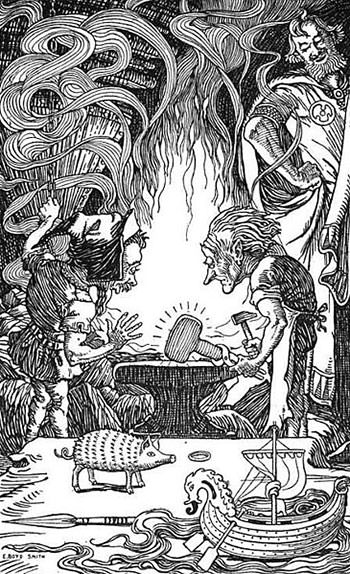
#3 Hreidmar The Sorcerer
According to the Völsunga saga in Snorri Sturluson’s prose Edda, Hreidmar was a sorcerer and the father of Regin, Fafnir, Ótr, Lyngheid and Lofnheid. Once when the three Gods Odin, Loki and Honir were on their travels exploring the worlds, they came across an otter who had just caught a fish. Loki was quick to get hold of a stone and killed the otter in one throw. He then picked the salmon under one arm and the limp otter under the other, as the others were delighted in expectation of a good meal. As the trio continued, they came across a hut which belonged to a farmer named Hreidmar. The trio requested lodgings for the night and in exchange offered the owner and his family to share their food for the night, the otter and the salmon.
Soon after in the story, it is revealed that Hreidmar is a sorcerer and the otter was in fact his shape shifting son. Wanting revenge Hreidmar used magic and tied down the three Gods with the help of his sons Regin and Fafnir. He then proposed to kill the Gods in retribution, but Odin pleaded innocence and asked for a chance to pay ransom. The sorcerer thought and then called for the dead otter’s skin. He wanted the Gods to fill it with red gold and then to further cover it fully in red gold.
Loki is tasked with bringing this red gold and firstly makes a journey to meet Aegir and Ran (God and Goddess of the Sea). He borrows Ran’s drowning net and proceeds to the lyre of Andvari, a large echoing chamber with a pool. Here Loki uses his net and catches a furious looking pike with Ran’s net. This long bodied fish is soon revealed as the dwarf Andvari who is forced to lead Loki to his golden treasure. Loki then makes Andvari to fill all the red gold in two sacks and also manages to extract a golden ring that the dwarf was attempting to hide. As Loki leaves the frustrated dwarf curses him saying that his gold and ring would destroy whosoever will own it.
Loki then returns to Hreidmar and the three Gods fill the otter with gold and then cover it with gold using the two sacks. When Hreidmar observes that one small part is uncovered, they use the ring of Andvari as well to satisfy the greedy sorcerer. Finally having saved Odin and Honir, Loki smiles before they leave and utters Andvari’s curse in a low voice “Take that ring! My curse on that ring and that gold! It will destroy whosoever owns it.”
#4 Encounter With Thiazi
According to the Skáldskaparmál; the second part of Snorri Sturluson’s prose Edda and the skaldic poem Haustlöng, Thiazi was a jötunn (type of giant race) who lived in Thrymheimr, located in Jötunheimr (realm of the jötunn). Once the three Gods Odin, Loki and Honir were on a journey. Travelling long through the mountains and wilderness the trio grew hungry and began looking for food. Hunting from a herd of oxen in the valley they quickly built an earth oven and began cooking their meal. However the group soon became frustrated and realized that their meat was not cooking despite all their efforts. A voice then spoke to them from the oak tree above, this was the jötunn Thiazi who had taken the form of a giant eagle and was not allowing the food to cook. Thiazi said that if he was allowed the first portion of the ox, he would allow the meat to cook so that the Gods may relish it. To this the three Æsir Gods agreed and Thiazi flew down and began consuming the raw ox. As the jötunn took huge bites, and more and more of the oxen disappeared into his mouth, Loki began losing his temper, finally leading him to grab his long staff and strike Thiazi. However the weapon stuck fast to the jötunn’s body, and as Thiazi flew away so did Loki along with him. As the giant eagle flew high and across lands Loki’s legs banged against the trees and stones and he begged to be let down on the ground. Thiazi finally agreed only after extracting an oath from Loki that the later would lure the Goddess Iðunn (Idun) along with her magical apples out of Asgard (realm of the Gods).

#5 The Kidnapping of Idun
Iðunn (Idun) is among the lesser known Goddesses of Norse mythology, associated with spring and rejuvenation. Her role in the Norse pantheon is however vital as the Æsir Gods derive their youthful appearance and immortality by consuming her magical apples (epli). As mentioned above, Loki was once carried off by the jötunn named Thiazi and had to make a promise in exchange for his release, that he would lure Idun out of Asgard. Honoring his commitment to Thiazi, he tricked Idun out of Asgard into a nearby forest, telling her that he had found some apples that she might think worth having, and that she should bring her own apples with her to compare with them. Thiazi in shape of an eagle was lurking around for an opportunity, and as soon as Idun was out of the protection of Asgard he flew down and kidnapped her, taking her to Thrymheimr (home of Thiazi) in Jötunheimr (realm of the jötunn).
Now with Idun and her apples missing the Gods began to grow old and their immortality was threatened. When they realized that Loki was behind all this they confronted him in anger and demanded the return of the Goddess. Finding himself in trouble yet again, Loki decided to make some amends. He borrowed the magical coat of Freyja, transformed into a falcon and flew to Jötunheimr. On reaching Thrymheimr Loki found Idun to be alone, he used a spell to transform her into a nut and began carrying her in his claws towards Asgard. When Thiazi realized what had happened he was quick to pursue Loki towards Asgard. As Loki neared Asgard, the Gods saw him carrying a nut and followed closely by an eagle. They responded quickly by lighting a fire and as Thiazi tried to grab the nut from Loki’s claws, Thiazi’s wings caught fire and he perished to his death.
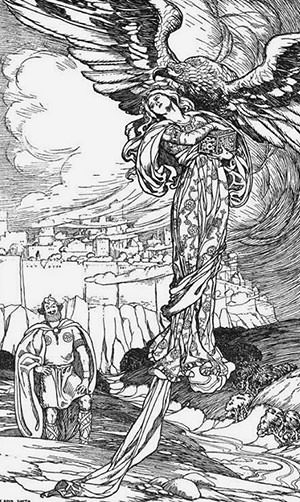
#6 The Death of Baldr
In Norse mythology, Baldr was the most handsome among the Æsir. He was the God of light, joy and the summer suns, and the son of Odin and Frigg (King and Queen of the Æsir). Once Baldr and his mother Frigg both had the same dream, a nightmare regarding Baldr’s death. The dream deeply disturbed Baldr who soon became depressed. To re-insure her beloved son, Frigg made every object and material on earth take an oath, to never hurt Baldr in anyway. All objects made this vow except mistletoe. The mischief making Loki became aware of this. The Gods were once engaged in a new pastime of hurling objects at Baldr, which would bounce off to everyone’s amusement. Loki thus made a magical spear (or arrow) of mistletoe and hurried to the place of recreation. Loki then gave the weapon to Baldr’s brother, the blind god Höðr who then inadvertently killed his brother with it. Hearing of her son’s death, Frigg was crestfallen and resolved to change his fate. She sent Hermodr (messenger God and Baldr’s brother) to the underworld to ransom Baldr’s soul. Hel (Goddess of death) agreed but on a condition, that all living things should weep for Baldr. Frigg was quick to set about the task and was able to convince all but one, a giantess with the name Thokk which may have been none other than Loki in disguise. Thus Baldr could not be saved and had to stay in the underworld.
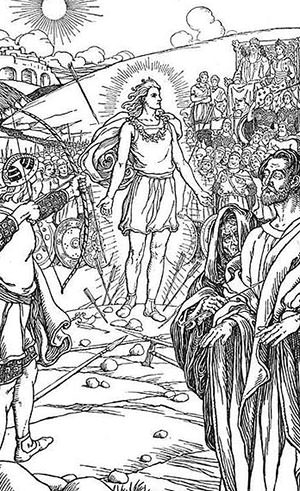
#7 Lokasenna
The Norse composition Lokasenna (Loki’s truth telling) is a flyting match (verbal battle) between the Gods and Loki, during a feast given by the sea God named Ægir (aka Gymir). Once Ægir invited all the Gods to a feast. He appointed his servants Fimafeng and Eldir to welcome the guests into the feast hall, who were also heaping praise upon the guests as they entered. The troublemaker Loki however grew incredibly jealous during these praises and slew Fimafeng in a fit of rage. He was thus driven away by the gods, who then feasted and drank in the hall.
Loki however returned to the feast yet again and demanded a seat and ale. On being told that he is unwelcome by Bragi (God of poetry), Loki reminded Odin (Æsir chief) of an ancient oath and got himself invited to the table. He then challenged Bragi and questioned his courage, thereby insulting him. When Idun (Goddess of rejuvenation and Bragi’s wife) tried to hold back her husband, Loki called her a sexually lose woman. Gefjon was the next to speak whom Loki silenced with a critique. When Odin interrupted him, the all father God was not spared either and Loki called him unjust and unmanly. Odin’s wife Frigg (Goddess of marriage, love and magic) then tried to calm the guests by saying that old tales should not be retold. Loki however targeted her as well accusing her of betraying Odin with his brothers Vili and Vi. The conversation continued with Freyja, Njord, Tyr and Byggvir confronting Loki and each receiving a piece of Loki’s sharp tongue. Finally Thor who was absent during the feast arrived and immediately warned Loki to be silent.

Loki then began abusing the God of thunder questioning Thor’s anger and taunting him, saying that Thor will not be so bold to fight against the wolf when he swallows Odin at Ragnarök (end of time). He further made fun of Thor’s journeys to the east where Thor supposedly cowered under the glove of the giant Skrymir. Thor became furious and threatened Loki with his hammer. Finally Loki left the scene saying that he had shown the Gods and their sons the sharp edge of his tongue. Loki also complimented Thor before leaving, saying that only Thor’s threats may be taken seriously.
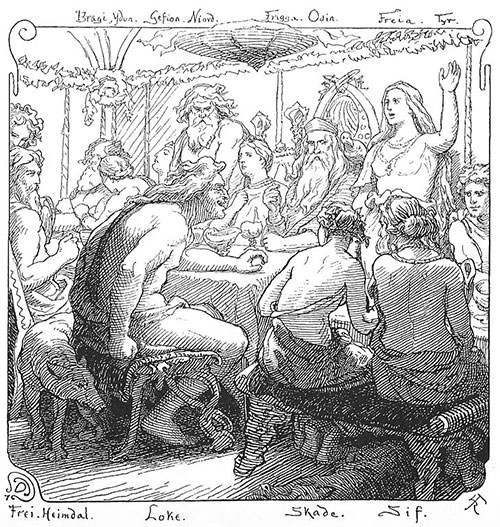
#8 Captured By The Gods
Loki had always brought trouble upon the Æsir (tribe of Gods) but his involvement in Baldr’s death and abusing the Gods at Ægir’s (sea God) feast, meant that their patience had run out with him. Loki soon realized that the Gods would now come after him and fled from Asgard (realm of the Gods). He hid himself atop a mountain where he built himself a house with four doors so that he could watch his pursuers from all directions. During the day he would shape shift himself into a salmon and hide in the waters nearby, and by night he would fish for his food and sustain himself. The Gods were indeed looking for Loki seeking for his punishment and Odin perceived his whereabouts. When Loki saw the Æsir approach he burnt his fishing net, quickly transformed into a salmon and hid in the water. The Gods sewed their own net and tried to catch him but Loki successfully evaded them. Knowing well that it would be impossible to evade the net forever, Loki decided to take a big risk by jumping downstream and swimming to the sea. However when the salmon finally made the leap, it was caught by Thor. Loki struggled to be free but Thor held him fast by his tail fins.
#9 Punishment of Loki
The Æsir had over time gotten tired of Loki’s mischief and insults, he had become more annoying, deceiving and dangerous. After recognizing his hand in Baldr’s death, the Gods decided to punish him and captured him. Loki was then taken to a cavern and meted out a cruel punishment for his misdeeds. His two sons Vali and Nari were summoned. Vali was transformed into a wolf, who then killed his own brother Nari leaving his entrails across the cave floor. Loki was now tied to the rocks with the entrails of his own son and Skadi (jötunn wife of sea God Njörd, Goddess of hunt) placed a poisonous snake on a rock above his head, where it dripped venom onto his face. Loki’s devoted wife Sigyn stayed with him in this cave holding a dish above her husband’s face to collect the venom and protect him. But every once in a while the dish would be full and she would be compelled to turn away and empty it. At these moments the venom dripped on Loki’s face and he so screamed and writhed in pain that the very earth trembled. Loki would remain in the cave until the beginning of Ragnarök (equivalent to Norse doomsday).
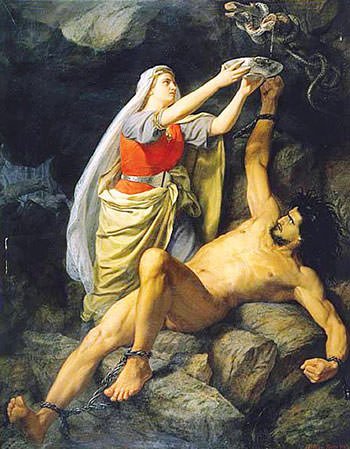
#10 Ragnarok And Heimdall
In Norse mythology, Ragnarök is a foretold doomsday event where the worlds would collapse through natural disasters, war of the Gods and other catastrophic events. Ragnarök begins with roosters crowing a warning to the nine worlds of the Norse. Two sons of Fenris the wolf begin the long winter which would last 3 long years, with Sköll swallowing the sun and Hati swallowing the moon. In the third year of the Great Winter, the Gods battle one another to the death of both combatants. Loki plays a prominent role during Ragnarök freeing himself from his chains and fighting along the with the jötnar (type of giant race) against the Gods. His two children from the jötunn Angrboða; the world serpent Jörmungandr and the wolf Fenrir play vital roles during Ragnarök. They in fact are the causes of death of the most prominent Æsir Gods, Thor and Odin respectively. Some Norse poems also suggest that Loki helped to get the giants to Asgard by sailing them there on his ship Naglfar. In the final battles of Ragnarök, Loki is supposed to face Heimdall, Odin’s son and the guardian of Asgard. During this final struggle, they are both destined to die at each others hands.

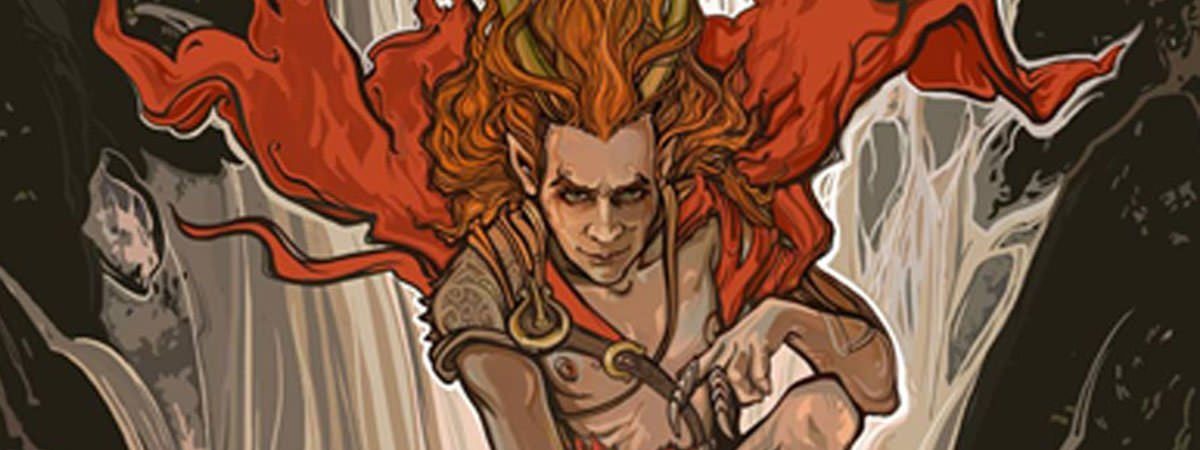
Interested in current studies relating to the Valley of the God’s and the Norse culture.